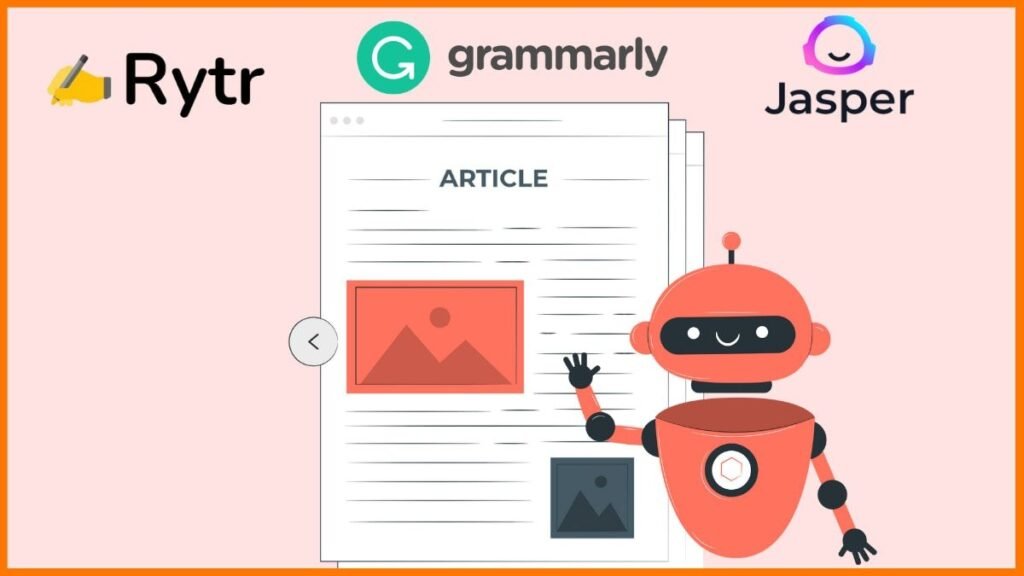Blogging can be a rewarding way to share your thoughts, ideas, and expertise with the world. However, consistently producing high-quality content can be challenging. This is where AI writing tools come in handy. These tools can help you generate ideas, draft articles, and optimize your content for search engines. We’ll explore the best AI writing tools for bloggers, offering practical tips on how to use them effectively to enhance your blogging efforts.
Understanding AI Writing Tools
What Are AI Writing Tools?
AI writing tools are software applications that use artificial intelligence to assist with various aspects of the writing process.
These tools can help generate content, improve grammar and style, and optimize text for search engines. By analyzing vast amounts of data, AI tools can mimic human writing patterns, making them incredibly useful for bloggers.
Why Bloggers Should Use AI Writing Tools
Using AI writing tools can save time, enhance creativity, and ensure your content is polished and professional. These tools can help you overcome writer’s block, generate fresh ideas, and ensure your writing is free from grammatical errors.
Additionally, they can help optimize your content for SEO, increasing the likelihood that your blog posts will rank higher in search engine results.
Top AI Writing Tools for Bloggers
Jasper (formerly Jarvis)
Jasper is an AI writing assistant designed to help you create high-quality content quickly and efficiently.
One of Jasper’s standout features is its ability to understand and mimic your writing style, making it an excellent tool for maintaining a consistent voice across your blog. By inputting a brief or topic, Jasper can generate detailed outlines and drafts that you can refine and personalize.
To maximize Jasper’s potential, use it to streamline your brainstorming sessions. Start by feeding Jasper a general topic relevant to your audience, such as “startup growth strategies.” Allow Jasper to generate a detailed outline and initial draft.
This saves time and provides a solid foundation for your content. You can then focus on adding personal anecdotes, case studies, and unique insights, transforming the draft into a compelling blog post that resonates with your readers.
Copy.ai
Copy.ai is a versatile AI writing tool that offers various templates for different types of content, including blog posts, product descriptions, and social media updates. Its intuitive interface makes it easy to use, even for those who are new to AI writing tools. Copy.ai excels at generating engaging content that captures the reader’s attention.
Leverage Copy.ai for content diversification. For instance, if you are writing a blog post on “innovative marketing techniques,” use Copy.ai to generate different sections of the post.
You can also use it to create complementary social media posts and email newsletters. This integrated approach ensures consistency across your marketing channels and maximizes the reach and impact of your content.
Writesonic
Writesonic is designed to help bloggers create SEO-friendly content efficiently. It offers features like blog post generation, ad copy creation, and even eBook writing. Writesonic’s AI understands SEO nuances, ensuring your content is optimized for search engines from the get-go.
Utilize Writesonic’s SEO capabilities to enhance your content strategy. Start by inputting your main topic, such as “digital transformation in small businesses,” and let Writesonic generate a draft.
Focus on the SEO recommendations provided by Writesonic to ensure your content includes relevant keywords and follows best practices. This proactive approach helps improve your content’s visibility on search engines, driving more organic traffic to your site.
Grammarly
Grammarly is an essential tool for ensuring your content is clear, engaging, and error-free. Beyond grammar and spell-checking, Grammarly provides suggestions for improving readability and coherence, making it a comprehensive writing assistant.
Integrate Grammarly into your content review process. After generating a draft with tools like Jasper or Writesonic, use Grammarly to polish the content.
Pay special attention to Grammarly’s tone and style suggestions to ensure your content aligns with your brand voice. For instance, if your blog targets a professional audience, Grammarly can help you maintain a formal tone throughout your posts.
SurferSEO
SurferSEO is a powerful tool for optimizing your content for search engines. It analyzes top-ranking pages for your target keywords and provides data-driven recommendations to enhance your content’s SEO performance.
Incorporate SurferSEO into your content planning and optimization phases. When writing a blog post on a competitive topic like “fintech innovations,” use SurferSEO to analyze the top-ranking articles.
Follow its recommendations for keyword usage, content structure, and word count to ensure your post is competitive. This strategic use of SurferSEO can significantly boost your content’s chances of ranking high in search engine results.
Frase
Frase is an AI-powered content creation tool that excels in research and writing. It provides comprehensive outlines based on top-performing content and suggests relevant information to include, ensuring your content is thorough and well-researched.
Use Frase to streamline your research process. For a topic like “remote team management,” Frase can generate an outline based on successful articles. Incorporate these insights to structure your blog post effectively.
Additionally, use Frase’s suggestions for subtopics and questions to create content that addresses your audience’s pain points and interests comprehensively.
Rytr
Rytr is a budget-friendly AI writing tool that offers a variety of writing templates, making it suitable for bloggers on a tight budget. It can generate content for blog posts, social media, emails, and more.
For startups with limited resources, Rytr provides a cost-effective solution for content creation. Use Rytr to generate initial drafts and then refine them manually.
For instance, if you’re writing a post on “entrepreneurial mindset,” Rytr can provide a good starting point. You can then enhance the content with your unique experiences and insights, ensuring it remains authentic and valuable.
Wordtune
Wordtune helps improve the readability and clarity of your writing by suggesting alternative phrasings and restructuring sentences. It’s particularly useful for refining content and making it more engaging.
After drafting your content with an AI tool like Jasper or Copy.ai, use Wordtune to enhance readability. If your blog post on “sustainable business practices” has complex sentences, Wordtune can suggest simpler alternatives.
This ensures your content is accessible to a broader audience, improving engagement and readability.
Integrating AI Writing Tools into Your Blogging Workflow
Planning Your Content
Before using AI writing tools, have a clear content plan. Define your target audience, main topics, and content goals. Use AI tools like Jasper and Copy.ai to generate ideas and outlines based on your plan.
For instance, if your blog focuses on “startup advice,” create a content calendar with topics like “funding strategies,” “marketing tips,” and “scaling techniques.”
Generating and Refining Content
Use AI tools to generate drafts, but always refine and personalize the content. Start with a tool like Writesonic to create an SEO-friendly draft. Then, enhance the content with your unique voice and insights.
Use Grammarly and Wordtune to ensure your writing is polished and engaging.
Optimizing for SEO
SEO optimization is crucial for driving traffic to your blog. Use tools like SurferSEO and Frase to analyze and optimize your content.
Follow their recommendations for keyword usage, content structure, and other SEO best practices.
Ensuring Consistency and Quality
Consistency and quality are key to building a successful blog. Use Grammarly and ProWritingAid to maintain a consistent tone and style.
Regularly review and update your content to ensure it remains relevant and valuable to your audience.
Enhancing Your Blogging with AI Writing Tools

Grammarly
Grammarly is more than just a grammar checker; it’s a comprehensive writing assistant that helps ensure your content is clear, engaging, and error-free.
Grammarly uses AI to analyze your writing for grammar, spelling, punctuation, and style issues. It also provides suggestions to improve readability and coherence.
For example, if you’re writing a blog post about “remote work productivity,” Grammarly can help you refine your language, suggest synonyms to avoid repetition, and ensure your tone is consistent.
This results in polished, professional content that resonates with your readers.
SurferSEO
SurferSEO is an AI tool that focuses on optimizing your content for search engines. It analyzes top-ranking pages for your target keywords and provides data-driven recommendations to improve your content.
This includes suggestions for keyword usage, content structure, and word count.
If you’re writing a blog post on “how to start a podcast,” SurferSEO can analyze competing articles and suggest ways to make your content more comprehensive and SEO-friendly. By following these recommendations, you can increase the chances of your blog post ranking higher in search engine results, attracting more organic traffic.
Frase
Frase is an AI-powered content creation tool that helps you research and write high-quality content quickly. It provides a comprehensive outline based on top-performing content and suggests relevant information to include.
Frase also offers tools to optimize your content for SEO.
For instance, if you’re writing about “sustainable living practices,” Frase can generate an outline based on the most successful articles on this topic. It can also suggest subtopics, questions to answer, and statistics to include, ensuring your content is thorough and well-researched.
How to Integrate AI Writing Tools into Your Workflow
Start with a Strong Topic
Before using AI writing tools, it’s essential to have a clear topic in mind. A well-defined topic helps the AI generate relevant and focused content.
Use tools like Jasper or Copy.ai to brainstorm and refine your topic.
For example, if you want to write about “vegan meal planning,” you can input this topic into Jasper. The AI will suggest related topics, subtopics, and questions that readers might have. This helps you create a detailed outline and ensure your content covers all relevant aspects.
Generate and Refine Your Draft
Once you have your topic and outline, use AI tools like Writesonic or Copy.ai to generate a draft. These tools can create a solid foundation for your blog post, which you can then refine and personalize.
For instance, after generating a draft on “tips for improving mental health,” you can add your personal experiences, anecdotes, and expert quotes to make the content more engaging and authentic.
Optimize for SEO
Optimizing your content for SEO is crucial for driving traffic to your blog. Use tools like SurferSEO and Frase to analyze your draft and make data-driven recommendations for improvement.
These tools can suggest keywords, content structure changes, and other SEO best practices.
For example, if your draft on “fitness routines for busy professionals” lacks keyword density, SurferSEO can suggest where to add keywords naturally. This ensures your content is optimized for search engines without compromising readability.
Ensuring Quality and Consistency with AI Writing Tools
Editing and Proofreading
Editing and proofreading are critical steps in the content creation process. AI tools like Grammarly and Hemingway Editor can help you refine your content to ensure it’s clear, concise, and free from errors.
Grammarly not only checks for grammar and spelling mistakes but also provides suggestions for improving sentence structure and word choice. For example, if you’re writing a blog post about “the benefits of mindfulness meditation,” Grammarly can help you ensure that your sentences flow smoothly and your points are clearly articulated.
Hemingway Editor focuses on readability, highlighting complex sentences and passive voice. If your content on “how to boost productivity” is difficult to read, Hemingway Editor will suggest ways to simplify your language and make your writing more engaging.
Maintaining a Consistent Tone
Maintaining a consistent tone across your blog posts is essential for building your brand identity. AI tools can help you achieve this by analyzing your writing style and ensuring it aligns with your desired tone.
Tools like Grammarly and ProWritingAid offer tone detection features that help you maintain consistency. For instance, if you want your blog to have a friendly and conversational tone, these tools can flag sentences that sound too formal or technical.
This ensures that your content on topics like “easy cooking tips for beginners” maintains a casual and approachable tone.
Advanced Features of AI Writing Tools
Content Personalization
Personalized content can significantly increase reader engagement. AI tools like HubSpot and Marketo can analyze user data to help you create personalized content that resonates with your audience.
For example, if your blog caters to a diverse audience with different interests, you can use AI to segment your readers and tailor content to each group. If you’re writing about “travel destinations,” AI can help you create personalized guides for different types of travelers, such as solo travelers, family vacations, or adventure seekers.
Content Repurposing
Repurposing content is an effective way to maximize your content’s reach and lifespan. AI tools can help you transform existing content into different formats, making it easier to reach a broader audience.
Tools like Lumen5 can turn your blog posts into engaging videos. If you have a popular article on “work-life balance strategies,” Lumen5 can help you create a video summarizing the key points with visuals and animations.
This allows you to share your content on platforms like YouTube and social media, reaching a wider audience.
Real-Time Collaboration
Collaborating with team members or guest writers can enhance your content. AI tools like Google Docs and Grammarly Business offer real-time collaboration features, allowing multiple users to work on a document simultaneously.
For instance, if you’re co-writing an article on “digital marketing trends,” you and your co-author can use Google Docs to write and edit the content in real-time.
Grammarly Business can help ensure the content is grammatically correct and stylistically consistent, making the collaboration process seamless and efficient.
Success Stories with AI Writing Tools

Increasing Blog Traffic
A tech startup used Jasper and SurferSEO to enhance their blog content and saw a significant increase in organic traffic. By generating SEO-optimized drafts with Jasper and fine-tuning them with SurferSEO, they improved their search engine rankings and attracted more visitors to their site.
Their blog on “emerging tech trends” became a go-to resource in their industry, driving engagement and conversions.
Streamlining Content Creation
A lifestyle blogger integrated Copy.ai and Grammarly into their content creation process, reducing the time spent on writing and editing by half. By using Copy.ai to generate initial drafts and Grammarly to refine the content, they were able to publish more frequently without compromising quality.
Their consistent posting schedule led to a steady growth in followers and increased reader engagement.
Tips for Maximizing the Benefits of AI Writing Tools
Combining Human Creativity with AI Efficiency
While AI writing tools can significantly enhance your content creation process, it’s essential to combine their efficiency with human creativity. AI can generate drafts and optimize content, but the unique touch of human creativity makes your content stand out.
For example, after using Jasper to draft a post on “minimalist living tips,” spend time adding personal stories, unique insights, and engaging anecdotes. This combination of AI efficiency and human creativity ensures that your content is both high-quality and uniquely engaging.
Regularly Updating Your Knowledge of AI Tools
AI writing tools are continually evolving, with new features and improvements being added regularly. To make the most of these tools, stay updated on the latest developments and updates.
Subscribe to newsletters, follow industry blogs, and participate in webinars to keep your knowledge current.
For instance, if Writesonic releases a new feature for generating more detailed outlines, learning how to use this feature can further streamline your content creation process. Staying informed about updates ensures you’re leveraging the full potential of AI tools to enhance your blogging efforts.
Customizing AI Tool Settings
Many AI writing tools offer customizable settings that allow you to tailor the output to your specific needs. Spend time exploring these settings to optimize the tool’s performance for your content.
For example, Jasper allows you to set the tone and style of the generated content. If you prefer a casual, conversational tone for your blog, adjusting these settings ensures that the AI-generated content aligns with your desired voice. Customizing settings helps you maintain consistency and quality across your blog posts.
Using AI for Content Planning and Strategy
AI tools can also assist in content planning and strategy, helping you identify trends, gaps, and opportunities in your niche. Tools like BuzzSumo and Ahrefs can analyze competitors’ content, track trending topics, and suggest potential content ideas.
For instance, if you’re running a fitness blog, using AI to analyze top-performing content in your niche can reveal popular topics like “home workout routines” or “nutrition tips for athletes.” You can then plan your content calendar around these trends, ensuring your blog remains relevant and engaging.
Ethical Considerations When Using AI Writing Tools

Ensuring Content Originality
While AI tools can generate content quickly, it’s essential to ensure that the content is original and not plagiarized. Always review and edit AI-generated content to add your unique voice and perspective.
Use plagiarism checkers to verify originality before publishing.
For example, if you use AI to draft a post on “digital detox benefits,” ensure that the information is accurate and presented in your unique style. Adding personal experiences and expert quotes can differentiate your content from others.
Transparency with Your Audience
Being transparent with your audience about the use of AI in your content creation process can build trust and credibility. Let your readers know if you use AI tools to assist with drafting or optimizing content.
For instance, you can include a note at the end of your blog post explaining that AI was used to generate the initial draft, which you then refined and personalized. This transparency shows your commitment to producing high-quality content while leveraging advanced tools.
Future Trends in AI Writing Tools
Enhanced Personalization
Future AI writing tools are expected to offer even more advanced personalization features. These tools will analyze user behavior and preferences in greater detail, allowing for highly tailored content recommendations and writing assistance.
For startup founders, this means being able to create highly targeted content that resonates deeply with specific audience segments. As personalization technology advances, AI tools will become even more integral to effective content marketing strategies.
Integration with Other Marketing Tools
AI writing tools are likely to become more integrated with other marketing tools, offering a seamless experience across different aspects of content creation and marketing.
Integration with email marketing platforms, social media management tools, and analytics software will streamline workflows and enhance efficiency.
For example, an AI writing tool integrated with your email marketing platform could automatically generate personalized email campaigns based on the latest blog posts. This integrated approach ensures consistency and maximizes the impact of your content marketing efforts.
Wrapping it up
AI writing tools are game-changers for bloggers and startup founders, offering powerful assistance in creating high-quality, consistent, and engaging content. By leveraging tools like Jasper, Grammarly, Hemingway Editor, and Copyscape, you can streamline your content creation process, maintain a consistent brand voice, and ensure originality.
Integrating these AI tools into your workflow will enhance your blogging efforts, drive engagement, and help establish a strong, trustworthy brand. Embrace AI to elevate your content strategy and achieve success in your blogging endeavors.
READ NEXT:
- The Intersection of Sports and Social Media: Key Statistics
- Website Marketing Statistics: Key Data Points for 2024
- How Much Time Do We Spend on Social Media? Key Statistics
- Law Firm Marketing: Key Statistics and Best Practices
- Budgeting for Small Business Marketing: Essential Statistics





















Comments are closed.